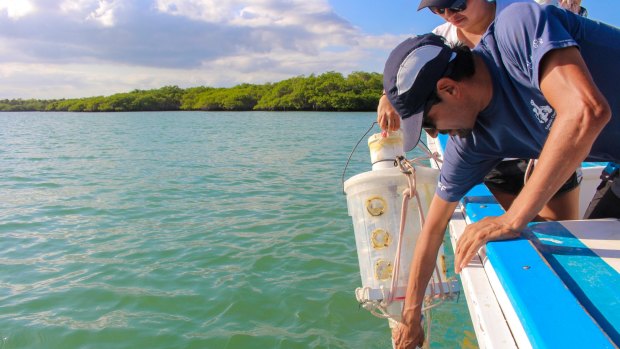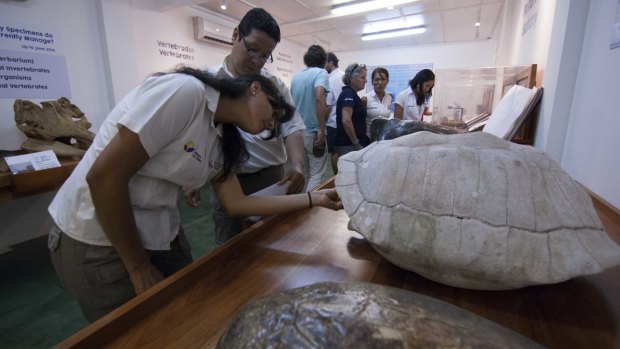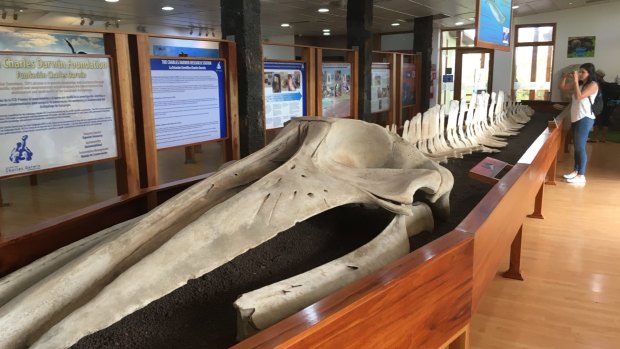This was published 4 years ago
Galapagos Islands, Ecuador: What to do about too many tourists?
By Rob McFarland

Daniel Unda from the Charles Darwin Foundation (CDF) on Santa Cruz Island.
"There are just too many tourists coming here," is the blunt assessment by Dr Maria Paladines, science director at the Charles Darwin Foundation (CDF) on Santa Cruz Island in the Galapagos. "Sites are getting saturated so there's demand to open new ones, which then puts pressure on precious resources like energy and water."
When the CDF was formed in 1959, its primary aim was to study the Ecuadorian archipelago's flora and fauna. Now, 60 years later, it's increasingly turning its attention to tourism-related issues such as the introduction of invasive species and plastic pollution.
While the Galapagos only has around 30,000 residents, last year it welcomed more than 275,000 tourists. Many arrive on small-ship, expedition-style cruises, but increasingly people are choosing land-based trips instead. The amount of accommodation is expanding rapidly to meet the demand.

Tortoise shells at the Charles Darwin Research Station Exhibit Hall.
Why are people flocking here? Primarily, to see the archipelago's extraordinary diversity of wildlife – often at astonishingly close quarters. Many species have no natural predators so are almost comically tame. Excursions frequently involve tiptoeing around a blissfully nonchalant menagerie of sea lions, iguanas and birdlife.
The challenge is how to preserve this vulnerable ecosystem. At the Charles Darwin Research Station on Santa Cruz Island, visitors can learn more about the CDF's initiatives, which range from mapping shark migrations to tackling invasive species such as the blackberry bush. Sometimes the solutions are drastic – such as bringing in hunters from New Zealand to kill the feral goat population – or risky, such as introducing one species to eradicate another (we all know how well that went with the cane toad in Queensland).
Currently, there's a limit on the number of cruise passengers that can visit the archipelago but no cap on land-based tourism. All visitors are charged a $US100 fee to enter the Galapagos National Park and there have been discussions about raising this in a bid to control numbers.

Skeleton of Bryde's whale in Charles Darwin Research Station.Credit: Rob McFarland
Plastic pollution is another issue. The Galapagos Marine Reserve is the world's second largest marine reserve and keeping it pristine is critical to maintain its diversity. Last year the islands introduced a ban on polystyrene foam containers and plastic bags, straws and bottles, but its enforcement is erratic. Our luggage was scanned at Quito airport but two of our group had plastic bottles in their bags that weren't detected. In the ultimate irony, luggage is sealed after screening with a disposable plastic tie.
Last year the UK-based Galapagos Conservation Trust started a five-year project to study marine plastic pollution in the hope of eventually making the Galapagos Marine Reserve pollution free. The aim is to create a model that can be used by other regions around the world facing the same problem.
Ultimately, much of the responsibility falls on travellers. Not only to stop buying single-use plastics, but also to make smart decisions about the companies we travel with and to be mindful of the impact we're having on the places we visit. As Charles Darwin, the archipelago's most famous visitor, once said: "The love for all living creatures is the most noble attribute of man."
TRIP NOTES
Rob McFarland was a guest of Chimu Adventures.
MORE
STAY
Finch Bay, a National Geographic Unique Lodge of the World, is the only beachfront property in Puerto Ayora on Santa Cruz Island and has an extensive program of land- and sea-based excursions. See finchbayhotel.com
VISIT
The Charles Darwin Research Station, Puerto Ayora, Santa Cruz Island, is open daily, 8am-12.30pm and 2.30pm-5.30pm. Admission is free. See darwinfoundation.org
TOUR
Chimu Adventures can create a tailor-made Ecuador itinerary including flights, accommodation, transfers and tours. See chimuadventures.com
Sign up for the Traveller Deals newsletter
Get exclusive travel deals delivered straight to your inbox. Sign up now.